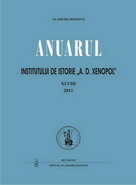Învăţământul de partid în românia comunistă. De la Universitatea Muncitorească la Şcoala Superioară de Partid „Ştefan Gheorghiu” (1945-1966)
PARTY STUDIES IN COMMUNIST ROMANIA. FROM THE WORKERS’ PARTY UNIVERSITY TO THE “ŞTEFAN GHEORGHIU” SUPERIOR PARTY SCHOOL (1945-1989)
Author(s): Gabriel AsanduluiSubject(s): History
Published by: Editura Academiei Române
Keywords: nomenklatura; party cadres; party schools; Romania; the “Ştefan Gheorghiu” Superior Party School
Summary/Abstract: As the Romanian Communist Party could abandon clandestinity and acceded to power, its lack of cadres became more obvious, since it had less than 1,000 members on 23rd of August 1944. In order to compensate for this shortfall, the Communist Party’s leadership decided to found a party studies system based on the Soviet model, whose aim was to train the group of cadres that would later be known as the nomenklatura. In Romania, as in other countries of the Eastern block, the party studies system lead to a process of “academic elevation” and the ranking of party schools. At the top of this system was the “Ştefan Gheorghiu” Academy of Social and Political Sciences, a genuine symbol of the Romanian party studies system. Established in 1945 as the workers’ party university, following the model set by the Superior School of Social Sciences of the Communist Party of the Soviet Union (PCU.S.), it was repeatedly subjected to extended reorganization and change of name. Thus, from 1945 to the early 50’s, it was known as the “Ştefan Gheorghiu” Party University, subsequently re-named the Superior Party School and then the Academy of Social and Political Sciences in 1966. This institution trained generations of cadres who contributed to consolidating and legitimating the communist regime. As an institution, the “Ştefan Gheorghiu” Superior Party School enabled the social and political elevation of the trainees, contributed to the formation of that “state aristocracy” which was to take over economic and political power in Romania after 1989.
Journal: Anuarul Institutului de Istorie »A.D. Xenopol« - Iaşi
- Issue Year: XLIX/2012
- Issue No: 49
- Page Range: 189-204
- Page Count: 15
- Language: Romanian

